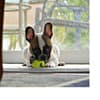Podcast
Questions and Answers
What is an incident report?
What is an incident report?
Method of documenting facts surrounding any unexpected event in a health care setting.
What types of incidents require an incident report?
What types of incidents require an incident report?
A resident falls, a mistake is made during resident care, something is broken or damaged, an angry outburst, sexual/physical abuse, someone getting injured on the job, or exposure to blood or blood-borne pathogens.
What should be included in an incident report?
What should be included in an incident report?
Who, what, when, where.
What is critical thinking?
What is critical thinking?
What are the 5 points to remember when using critical thinking skills?
What are the 5 points to remember when using critical thinking skills?
If a resident in a cast asks for water but simply looks at you, what should you do?
If a resident in a cast asks for water but simply looks at you, what should you do?
If two patients ring their call bells at the same time, which request should you address first?
If two patients ring their call bells at the same time, which request should you address first?
What happens if a patient eats before surgery when ordered NPO?
What happens if a patient eats before surgery when ordered NPO?
What should you do before giving coffee to a patient on thickened liquids?
What should you do before giving coffee to a patient on thickened liquids?
What should be done if salt is packed with a patient on a NAS diet?
What should be done if salt is packed with a patient on a NAS diet?
Which of the following should the nurse aide report to the nurse?
Which of the following should the nurse aide report to the nurse?
Which factors negatively affect a family member's decision to place their loved one in a facility?
Which factors negatively affect a family member's decision to place their loved one in a facility?
It is important to ask the family of an aphasic patient who was newly admitted about their likes and dislikes.
It is important to ask the family of an aphasic patient who was newly admitted about their likes and dislikes.
Which questions can you ask a family member about the patient?
Which questions can you ask a family member about the patient?
What is defecation?
What is defecation?
What is fecal impaction?
What is fecal impaction?
What is a prosthetic device?
What is a prosthetic device?
What is urination?
What is urination?
What is an amputation?
What is an amputation?
What is an orthotic device?
What is an orthotic device?
What is a supportive device?
What is a supportive device?
What is an adaptive device?
What is an adaptive device?
What is bowel training?
What is bowel training?
As health care providers, what should we always remember?
As health care providers, what should we always remember?
What are the goals of restorative care?
What are the goals of restorative care?
Guidelines for assisting with bladder retraining include all the following except:
Guidelines for assisting with bladder retraining include all the following except:
How long does bowel and bladder training take?
How long does bowel and bladder training take?
What are footboards used for?
What are footboards used for?
What are signs and symptoms of fecal impaction?
What are signs and symptoms of fecal impaction?
What type of incontinence may be related to NA not responding to call bell?
What type of incontinence may be related to NA not responding to call bell?
When should a resident need to use the restroom or be assisted?
When should a resident need to use the restroom or be assisted?
The purpose of the cleansing enema is to clean the colon by eliminating stool or feces or to stimulate bowel activity.
The purpose of the cleansing enema is to clean the colon by eliminating stool or feces or to stimulate bowel activity.
What is the NA's role in bowel/bladder training?
What is the NA's role in bowel/bladder training?
Which of the following can be a part of bowel and bladder training?
Which of the following can be a part of bowel and bladder training?
What is friction?
What is friction?
What is eczema?
What is eczema?
What is epidermis?
What is epidermis?
What is dermis?
What is dermis?
What is dermatitis?
What is dermatitis?
What are bony prominences?
What are bony prominences?
What is shearing?
What is shearing?
What is the integumentary system?
What is the integumentary system?
What is melanin?
What is melanin?
What are pressure points?
What are pressure points?
What are pressure ulcers?
What are pressure ulcers?
What is gangrene?
What is gangrene?
What is shingles?
What is shingles?
What are liver spots?
What are liver spots?
What is psoriasis?
What is psoriasis?
What is the cranial cavity?
What is the cranial cavity?
What is in the thoracic cavity?
What is in the thoracic cavity?
What is in the abdominal cavity?
What is in the abdominal cavity?
What is in the pelvic cavity?
What is in the pelvic cavity?
What is a malignant tumor?
What is a malignant tumor?
What is the first stage of pressure ulcers?
What is the first stage of pressure ulcers?
What is the second stage of pressure ulcers?
What is the second stage of pressure ulcers?
What is the third stage of pressure ulcers?
What is the third stage of pressure ulcers?
What is the fourth stage of pressure ulcers?
What is the fourth stage of pressure ulcers?
What is a common cause of pressure ulcers?
What is a common cause of pressure ulcers?
What are changes due to aging that are normal for the integument system?
What are changes due to aging that are normal for the integument system?
What is metastasis?
What is metastasis?
What should the NA remember when caring for older adults?
What should the NA remember when caring for older adults?
Where can pressure ulcers develop on an obese woman?
Where can pressure ulcers develop on an obese woman?
Which of the following are typical pressure points?
Which of the following are typical pressure points?
Which of the following can prevent pressure ulcers?
Which of the following can prevent pressure ulcers?
What is a fracture?
What is a fracture?
What is osteoarthritis?
What is osteoarthritis?
What is extension?
What is extension?
What is flexion?
What is flexion?
What is abduction?
What is abduction?
What is adduction?
What is adduction?
What is arthritis?
What is arthritis?
What is bone marrow?
What is bone marrow?
What are bones?
What are bones?
What is cardiac muscle?
What is cardiac muscle?
What is dorsiflexion?
What is dorsiflexion?
What is contracture?
What is contracture?
What are joints?
What are joints?
What are ligaments?
What are ligaments?
What is muscle atrophy?
What is muscle atrophy?
What is the musculoskeletal system?
What is the musculoskeletal system?
What is osteoporosis?
What is osteoporosis?
What is plantar flexion?
What is plantar flexion?
What is rheumatoid arthritis?
What is rheumatoid arthritis?
What are skeletal muscles?
What are skeletal muscles?
What are smooth muscles?
What are smooth muscles?
What are tendons?
What are tendons?
What is a sprain?
What is a sprain?
What is a compound fracture?
What is a compound fracture?
What is synovial fluid?
What is synovial fluid?
What is gout?
What is gout?
What is paraplegic?
What is paraplegic?
What is quadriplegic?
What is quadriplegic?
What is hemiplegic?
What is hemiplegic?
What is a hinge joint?
What is a hinge joint?
What is a ball and socket joint?
What is a ball and socket joint?
What is a pivot joint?
What is a pivot joint?
What is a long bone?
What is a long bone?
What is a short bone?
What is a short bone?
What is a flat bone?
What is a flat bone?
Flashcards
Incident Report
Incident Report
Documentation of unexpected events in a healthcare setting; not a public record.
Incident Types
Incident Types
Resident falls, care errors, damages, abuse, job injuries, exposure to pathogens.
Incident Report Details
Incident Report Details
Who, what, when, where, and how of an event; factual, not opinion-based.
Critical Thinking
Critical Thinking
Signup and view all the flashcards
Critical Thinking Questions
Critical Thinking Questions
Signup and view all the flashcards
Prioritizing Patient Needs
Prioritizing Patient Needs
Signup and view all the flashcards
NPO Order
NPO Order
Signup and view all the flashcards
Thickened Liquids
Thickened Liquids
Signup and view all the flashcards
Defecation
Defecation
Signup and view all the flashcards
Fecal Impaction
Fecal Impaction
Signup and view all the flashcards
Bowel/Bladder Training
Bowel/Bladder Training
Signup and view all the flashcards
Bowel/Bladder Training Guidelines
Bowel/Bladder Training Guidelines
Signup and view all the flashcards
Pressure Ulcers
Pressure Ulcers
Signup and view all the flashcards
Typical Pressure Points
Typical Pressure Points
Signup and view all the flashcards
Long Bones
Long Bones
Signup and view all the flashcards
Short Bones
Short Bones
Signup and view all the flashcards
Flat Bones
Flat Bones
Signup and view all the flashcards
Arthritis
Arthritis
Signup and view all the flashcards
Osteoarthritis
Osteoarthritis
Signup and view all the flashcards
Ligaments
Ligaments
Signup and view all the flashcards
Tendons
Tendons
Signup and view all the flashcards
Paraplegia
Paraplegia
Signup and view all the flashcards
Quadriplegia
Quadriplegia
Signup and view all the flashcards
Hemiplegia
Hemiplegia
Signup and view all the flashcards
Flexion
Flexion
Signup and view all the flashcards
Extension
Extension
Signup and view all the flashcards
Hinge Joints
Hinge Joints
Signup and view all the flashcards
Ball-and-Socket Joints
Ball-and-Socket Joints
Signup and view all the flashcards
Pivot Joints
Pivot Joints
Signup and view all the flashcards
Maintaining Patient Abilities
Maintaining Patient Abilities
Signup and view all the flashcards
Study Notes
Incident Reporting
- Incident reports document unexpected events in healthcare settings and are not public records.
- Types of incidents that require a report include: resident falls, errors in care, damages caused by healthcare personnel or residents, angry outbursts, abuse, job injuries, and exposure to bloodborne pathogens.
- Essential details for incident reports include who was involved, a description of events, actions taken, time, and location. Only factual information should be recorded, avoiding notation in resident charts.
Critical Thinking in Care
- Critical thinking in nursing aides involves providing safe patient care by applying learned facts, observations, and quick decision-making.
- Key questions for critical thinkers: What is my goal? What problem needs resolution? What information is required and where can I obtain it? What fundamental concepts apply? What am I overlooking?
Patient Assistance Guidelines
- When assisting patients unable to use their hands, such as bringing a straw for Mrs. Bailey who has both arms in casts.
- Prioritize patient needs; for instance, assist the patient requiring a bathroom visit first before addressing drink requests.
Dietary and Health Restrictions
- NPO (nothing by mouth) orders must be strictly followed; delivering food counteracts surgical preparations and may delay procedures.
- Patients like Mrs. Smith with swallowing issues must have medical clearance before consuming thickened liquids, such as coffee.
Reporting and Family Engagement
- Important to report significant emotional changes in residents like crying after family visits.
- Factors impacting family decision-making regarding residences include cleanliness, odors, and the care state of residents.
Bowel and Bladder Management
- Defecation is the process of eliminating feces; fecal impaction refers to prolonged feces retention.
- Bowel and bladder training requires consistent establishment of routines and can take 8-10 weeks.
- Guidelines include encouraging regular exercise, offering fluids as per schedule, and monitoring progress effectively.
Skin and Pressure Management
- Pressure ulcers are severe injuries resulting from prolonged pressure; signs include localized redness, blistering, and tissue loss.
- Typical pressure points include the elbows, shoulder blades, and sacrum; these can worsen with moisture, shearing forces, and friction.
Skeletal and Muscular Systems
- Understanding different bone types: long bones support weight, short bones facilitate movement, and flat bones protect organs.
- Arthritis denotes joint inflammation; osteoarthritis is degenerative joint disease affecting flexibility and pain.
- Connective structures: ligaments connect bones, while tendons link muscles to bones.
Paralysis and Mobility
- Types of paralysis include paraplegia (lower body), quadriplegia (full body), and hemiplegia (one side).
- Flexion and extension describe bending and straightening movements, respectively.
Joint Classifications
- Types of joints include hinge joints (elbows), ball-and-socket joints (hips/shoulders), and pivot joints (skull/spine), each facilitating specific types of movement.
Skin and Aging
- Aging skin changes include increased dryness, need for moisture, and disposition to pressure ulcers.
- Melanin is the pigment responsible for skin coloration, while conditions like eczema and psoriasis require careful management.
General Care Principles
- Encourage independence among residents, providing support rather than performing tasks for them.
- Focus on restoring and maintaining patient abilities, aiding in rehabilitation efforts.
Studying That Suits You
Use AI to generate personalized quizzes and flashcards to suit your learning preferences.





